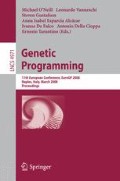Abstract
Research has shown that beyond a certain minimum program length the distributions of program functionality and fitness converge to a limit. Before that limit, however, there may be program-length classes with a higher or lower average fitness than that achieved beyond the limit. Ideally, therefore, GP search should be limited to program lengths that are within the limit and that can achieve optimum fitness. This has the dual benefits of providing the simplest/smallest solutions and preventing GP bloat thus shortening run times. Here we introduce a novel and simple technique, which we call Operator Equalisation, to control how GP will sample certain length classes. This allows us to finely and freely bias the search towards shorter or longer programs and also to search specific length classes during a GP run. This gives the user total control on the program length distribution, thereby completely freeing GP from bloat. Results show that we can automatically identify potentially optimal solution length classes quickly using small samples and that, for particular classes of problems, simple length biases can significantly improve the best fitness found during a GP run.
Access this chapter
Tax calculation will be finalised at checkout
Purchases are for personal use only
Preview
Unable to display preview. Download preview PDF.
References
McPhee, N.F., Miller, J.D.: Accurate replication in genetic programming. In: Eshelman, L. (ed.) Genetic Algorithms: Proceedings of the Sixth International Conference (ICGA 1995), 15-19 July, pp. 303–309. Morgan Kaufmann, San Francisco (1995)
Soule, T., Foster, J.A.: Removal bias: a new cause of code growth in tree based evolutionary programming. In: 1998 IEEE International Conference on Evolutionary Computation, 5-9 May, pp. 781–786. IEEE Press, Los Alamitos (1998)
Langdon, W.B., Soule, T., Poli, R., Foster, J.A.: The evolution of size and shape. In: Spector, L., Langdon, W.B., O’Reilly, U.-M., Angeline, P.J. (eds.) Advances in Genetic Programming 3, vol. 8, pp. 163–190. MIT Press, Cambridge (1999)
Dignum, S., Poli, R.: Generalisation of the limiting distribution of program sizes in tree-based genetic programming and analysis of its effects on bloat. In: Thierens, D., Beyer, H.-G., Bongard, J., Branke, J., Clark, J.A., Cliff, D., Congdon, C.B., Deb, K., Doerr, B., Kovacs, T., Kumar, S., Miller, J.F., Moore, J., Neumann, F., Pelikan, M., Poli, R., Sastry, K., Stanley, K.O., Stutzle, T., Watson, R.A., Wegener, I. (eds.) GECCO 2007: Proceedings of the 9th annual conference on Genetic and evolutionary computation, 7-11 July, vol. 2, pp. 1588–1595. ACM Press, New York (2007)
Soule, T., Foster, J.A.: Effects of code growth and parsimony pressure on populations in genetic programming. Evolutionary Computation 6(4), 293–309 (1998)
Luke, S., Panait, L.: A comparison of bloat control methods for genetic programming. Evolutionary Computation 14(3), 309–344 (2006)
Langdon, W.B.: Size fair and homologous tree genetic programming crossovers. Genetic Programming and Evolvable Machines 1(1/2), 95–119 (2000)
Crawford-Marks, R., Spector, L.: Size control via size fair genetic operators in the PushGP genetic programming system. In: Langdon, W.B., Cantú-Paz, E., Mathias, K., Roy, R., Davis, D., Poli, R., Balakrishnan, K., Honavar, V., Rudolph, G., Wegener, J., Bull, L., Potter, M.A., Schultz, A.C., Miller, J.F., Burke, E., Jonoska, N. (eds.) GECCO 2002: Proceedings of the Genetic and Evolutionary Computation Conference, 9-13 July, pp. 733–739. Morgan Kaufmann Publishers, San Francisco (2002)
Poli, R.: A simple but theoretically-motivated method to control bloat in genetic programming. In: Ryan, C., Soule, T., Keijzer, M., Tsang, E.P.K., Poli, R., Costa, E. (eds.) EuroGP 2003. LNCS, vol. 2610, pp. 204–217. Springer, Heidelberg (2003)
Zhang, B.-T., Mühlenbein, H.: Evolving optimal neural networks using genetic algorithms with Occam’s razor. Complex Systems 7, 199–220 (1993)
Zhang, B.-T., Mühlenbein, H.: Balancing accuracy and parsimony in genetic programming. Evolutionary Computation 3(1), 17–38 (1995)
Zhang, B.-T., Ohm, P., Mühlenbein, H.: Evolutionary induction of sparse neural trees. Evolutionary Computation 5(2), 213–236 (1997)
Langdon, W.B., Poli, R.: Foundations of Genetic Programming. Springer, Heidelberg (2002)
Poli, R., McPhee, N.F.: Exact schema theorems for GP with one-point and standard crossover operating on linear structures and their application to the study of the evolution of size. In: Miller, J., Tomassini, M., Lanzi, P.L., Ryan, C., Tetamanzi, A.G.B., Langdon, W.B. (eds.) EuroGP 2001. LNCS, vol. 2038, Springer, Heidelberg (2001)
Poli, R., Langdon, W.B., Dignum, S.: On the limiting distribution of program sizes in tree-based genetic programming. In: Ebner, M., O’Neill, M., Ekárt, A., Vanneschi, L., Esparcia-Alcázar, A.I. (eds.) EuroGP 2007. LNCS, vol. 4445, Springer, Heidelberg (2007)
Rosenfeld, A., Kak, A.C.: Digital Picture Processing, vol. 1,2. Academic Press, London (1982)
Koza, J.R. (ed.): Genetic Programming: On the Programming of Computers by Means of Natural Selection, USA, MIT Press, Cambridge (1992)
Iba, H.: Random tree generation for genetic programming. In: Ebeling, W., Rechenberg, I., Voigt, H.-M., Schwefel, H.-P. (eds.) PPSN 1996. LNCS, vol. 1141, pp. 144–153. Springer, Heidelberg (1996)
Author information
Authors and Affiliations
Editor information
Rights and permissions
Copyright information
© 2008 Springer-Verlag Berlin Heidelberg
About this paper
Cite this paper
Dignum, S., Poli, R. (2008). Operator Equalisation and Bloat Free GP. In: O’Neill, M., et al. Genetic Programming. EuroGP 2008. Lecture Notes in Computer Science, vol 4971. Springer, Berlin, Heidelberg. https://doi.org/10.1007/978-3-540-78671-9_10
Download citation
DOI: https://doi.org/10.1007/978-3-540-78671-9_10
Publisher Name: Springer, Berlin, Heidelberg
Print ISBN: 978-3-540-78670-2
Online ISBN: 978-3-540-78671-9
eBook Packages: Computer ScienceComputer Science (R0)

